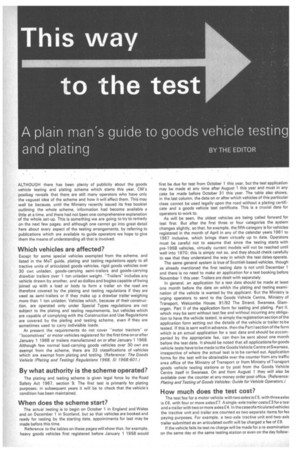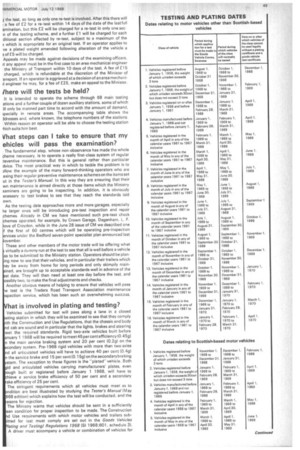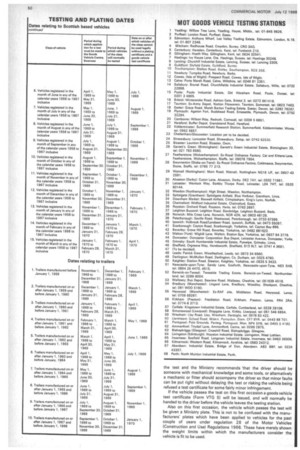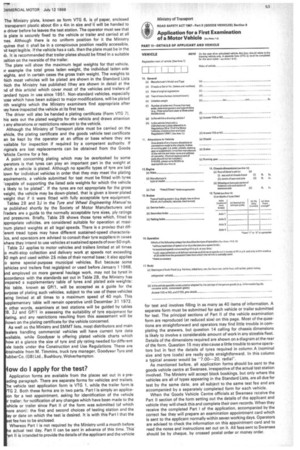This way to the test
Page 50

Page 51

Page 52

Page 55

If you've noticed an error in this article please click here to report it so we can fix it.
A plain man's c uide to goods vehicle testing
and plating BY THE EDITOR
ALTHOUGH there has been plenty of publicity about the goods vehicle testing and plating scheme which starts this year. CM's postbag reveals that there are still many operators who have only the vaguest idea of the scheme and how it will affect them. This may well be because, until the Ministry recently issued its free booklet outlining the whole scheme, information had become available a little at a time, and there had not been one comprehensive explanation of the whole set-up. This is something we are going to try to remedy on•the next few pages, and although one cannot go into great detail here about every aspect of the testing arrangements, by referring to publications which are available to guide operators we hope to give them the means of understanding all that is involved.
Which vehicles are affected?
Except for some special vehicles exempted from the scheme, and listed in the MoT guide, plating and testing regulations apply to all tractive units of articulated goods vehicles, rigid goods vehicles over 30 cwt unladen, goods-carrying semi-trailers and goods-carrying drawbar trailers over 1 ton unladen weight. "Trailers" includes any vehicle drawn by another, and so dollies and bogies capable of being joined up with a load or body to form a trailer on the road are therefore covered by the plating and testing regulations if they are used as semi-trailers or if they make up a drawbar trailer weighing more than 1 ton unladen. Vehicles which, because of their construction, are operated only under Special Types regulations are not subject to the plating and testing requirements, but vehicles which are capable of complying with the Construction and Use Regulations are covered by the plating and testing scheme, even if they are sometimes used to carry indivisible loads.
At present the requirements do not cover -motor tractors" or "locomotives" or motor vehicles registered for the first time on or after January 1 1968 or trailers manufactured on or after January 1 1968. Although few normal load-carrying goods vehicles over 30 cwt are exempt from the scheme, there are 33 classifications of vehicles which are exempt from plating and testing. (Reference: The Goods Vehicle (Plating and Testing) Regulations 1968, Si 1968:601.) By what authority is the scheme operated?
The plating and testing scheme is given legal force by the Road Safety Act 1967, section 9. The first test is primarily for plating purposes: in subsequent years it will be to check that the vehicle's condition has been maintained.
When does the scheme start?
The actual testing is to begin on October 1 in England and Wales and on December 1 in Scotland, but so that vehicles are booked and ready for testing by the starting date, appointments for test may be made before this time.
Reference to the tables on these pages will show that, for example, heavy goods vehicles first registered before January 1 1958 would first be due for test from October 1 this year, but the test application may be made at any time after August 1 this year and must in any case be made before October 31 this year. The table also shows, in the last column, the date on or after which vehicles of this particular class cannot be used legally upon the road without a plating certificate and a goods vehicle test certificate. This is a crucial date for operators to work to.
As will be seen, the oldest vehicles are being called forward for test first. But after the first three or four categories the system changes slightly, so that, for example, the fifth category is for vehicles registered in the month of April in any of the calendar years 1961 to 1967 inclusive, which brings them virtually up to date. Operators must be careful not to assume that since the testing starts with pre-1958 vehicles, virtually current models will not be reached until well into 1970: this is simply not so, and they should check carefully to see that they understand the way in which the test dates operate.
The same general system is true of Scottish based vehicles, though as already mentioned the first testing date is not until December 1 and there is no need to make an application for a test booking before November 1 this year. Trailers are dealt with separately.
In general, an application for a test date should be made at least one month before the date on which the plating and testing examination of the vehicle is wanted by the applicant. But the Ministry is urging operators to send to the Goods Vehicle Centre, Ministry of Transport, Welcombe House, 91/92 The Strand, Swansea, Glamorgan, Part II of the application form for testing and plating. Part II, which may be sent without test fee and without incurring any obligation to have the vehicle tested, is simply the registration section of the application form setting out the details of the vehicle or trailer to be tested. If this is sent well in advance, then the Part I section of the form which is an actual application for a test date and should be accompanied by the appropriate fee, can then be sent about one month before the test date. It should be noted that all applications for goods vehicle tests have to be ma de to the Goods Vehicle Centre a tSwe nsea, irrespective of where the actual test is to be ca rried out. Application forms for the test will be obtainable over the counter from any traffic area office of the Ministry of Transport or from Ministry of Transport goods vehicle testing stations or by post from the Goods Vehicle Centre itself in Swansea. On and from August 1 they will also be available over the counter at any money order post office. (Reference: Plating and Testing of Goods Vehicles: Guide for Vehicle Operators.)
How much does the test cost?
The test fee for a motor vehicle with two axles is £5, with threeaxle: is £6, with four or more axles £7. A single-axle trailer costs £3 for a tesi and a trailer with two or more axles £4. In the caseofa rticulatedvehicleF. the tractive unit and trailer are counted as two separate items for fe€ paying purposes. For example, a two-axle tractive unit and two-axis trailer submitted as an articulated outfit will be charged a fee of £9.
If the vehicle fails its test no charge will be made for a re-examination on the same day at the same testing station or even on the day follow
3 the test, so long as only one re-test is involved. After this there will a fee of £2 for a re-test within 14 days of the date of the lastfull amination, but this £2 will be charged for a re-test in only one sec of the testing scheme, and a further E1 will be charged for each ditional section affected by re-test, subject to a maximum of the 9 which is appropriate for an original test. If an operator applies to ve a plated weight amended following alteration of the vehicle a of £5 will be charged.
Appeals may be made against decisions of the examining officers, it any appeal must be in the first case to an area mechanical engineer the Ministry of Transport within 10 days of the test. A fee of £15 charged, which is refundable at the discretion of the Minister of ansport. If an operator is aggrieved at a decision of an area mechaniil engineer he may, for a fee of £25, make an appeal to the Minister.
/here will the tests be held?
It is intended to operate the scheme through 68 main testing ations and a further couple of dozen auxiliary stations, some of which ill only be manned part time to accord with the amount of demand, ipecially in remote areas. The accompanying table shows the ldresses and, where known, the telephone numbers of the stations. Within reason an operator will be able to choose the testing station 'Filch suits him best.
Vhat steps can I take to ensure that my ehicles will pass the examination?
The fundamental step, whose non-observance has made the whole cheme necessary, is to operate a really first-class system of regular reventive maintenance. But this is general rather than particular dvice. The most practical way in which to tackle the problem is to )Ilow the example of the many forward-thinking operators who are asing their regular preventive maintenance schemes on the items set ut in the Tester's Manual. In this way they are ensuring that their wn maintenance is aimed directly at those items which the Ministry xaminers are going to be inspecting. In addition, it is obviously ecessary to test brakes to see that they reach the standards laid own. • As the testing date approaches more and more garages, especially he larger ones will be introducing pre-test inspection and repair chemes. Already in CM we have mentioned such pre-test check 'chemes operated, for example, by Crown Garage, Dagenham, L. F. ove of Croydon, while in the June 28 issue of CM we described one f the first of 60 centres which will be operating pre-inspection ervices under the Bedford seven-point specialist plan announced last ovember.
These and other members of the motor trade will be offering what virtually a dummy run at the test to see that all is well before a vehicle as to be submitted to the Ministry station. Operators should be planing now to see that their vehicles, and in particular their trailers which ay be away from home for long periods and only skimpily mainined, are brought up to acceptable standards well in advance of the -St date. They will then need at least one day before the test, and ossibly two, to make the final adjustments and checks.
Another obvious means of helping to ensure that vehicles will pass e test is the Traders Road Transport Association maintenance spection service, which has been such an overwhelming success.
hat is involved in plating and testing?
Vehicles submitted for test will pass along a lane in a closed sting station in which they will be examined to see that they comply ith the Construction and Use Regulations, that the chassis and body nd cab are sound and in particular that the lights, brakes and steering eet the required standards. Rigid two-axle vehicles built before anuary 1 1968 will be required to meet 45 percent efficiency (0.45g) n the main service braking system and 20 per cent (0.2g) on the econdary system. Pre-1968 rigid vehicles with more than two axles nd all articulated vehicles will have to achieve 40 per cent (0.4g) n the service brake and 15 per cent (0.15g) on the secondarybra king stem. The exception to these figures is the "plated" vehicle. Both id and articulated vehicles carrying manufacturers' plates, even ough built or registered before January 1 1968, will have to hieve a service brake efficiency of 50 per cent and a secondary ake efficiency of 25 per cent.
The stringent requirements which all vehicles must meet as to ndition are best illustrated by studying the Tester's Manual (May 68 edition) which explains how the test will be conducted, and the asons for rejection.
The Ministry warns that vehicles should be sent in a sufficiently ean condition for proper inspection to be made. The Construction d Use requirements with which motor vehicles and trailers sub • itted for test must comply are set out in the Goods Vehicles lating and Testing) Regulations 1968 (SI 1968:601, schedule 3). A driver must accompany a vehicle or combination of vehicles for the test and the Ministry recommends That the driver should be someone with mechanical knowledge and some tools, or alternatively a mechanic or fitter should accompany the driver so that minor faults can be put right without delaying the test or risking the vehicle being refused a test certificate for some fairly minor infringement.
If the vehicle passes the test on this first occasion a goods vehicle test certificate (Form VTG 5) will be issued, and will normally be handed to the driver before the vehicle leaves the testing station.
Also on this first occasion, the vehicle which passes the test will be given a Ministry plate. This is not to be confused with the manufacturers' plates which have been applied to vehicles for the past couple of years under regulation 28 of the Motor Vehicles (Construction and Use) Regulations 1966. These have merely shown the weight limits within which the manufacturers consider the vehicle is fit to be used.
I
The Ministry plate, known as form VTG 6, is of paper, enclosed transparent plastic about 6in x 4in in size and it will be handed to e driver before he leaves the test station. The operator must see that is plate is securely fixed to the vehicle or trailer and carried at all nes. Although there is no uniform position for it the Ministry quires that it shall be in a conspicuous position readily accessible, id kept legible. If the vehicle has a cab, then the plate must be in the lb. It is recommended that trailer plates should be fitted in a suitable nition on the nearside of the trailer.
The plate will show the maximum legal weights for that vehicle, n• example the total gross laden weight, the individual laden axle .eights, and in certain cases the gross train weight. The weights to ,hich most vehicles will be plated are shown in the Standard Lists rhich the Ministry has published (they are shown in detail at the rid of this article) which cover most of the vehicles and trailers of tandard types in use since 1951. Non-standard vehicles, especially lose which have been subject to major modifications, will be plated pith weights which the Ministry examiners find appropriate after ley have inspected the vehicle at its first test.
The driver will also be handed a plating certificate (Form VTG 7). his sets out the plated weights for the vehicle and draws attention ) any alterations or restrictions relevant to the vehicle.
Although the Ministry of Transport plate must be carried on the ehicle, the plating certificate and the goods vehicle test certificate an be kept by the operator at an office or base where they are vailable for inspection if required by a competent authority. If ,riginals are lost replacements can be obtained from the Goods fehicle Centre for a fee.
A point concerning plating which may be overlooked by some iperators is that tyres can play an important part in the weight at vhich a vehicle is plated. Although no specific types of tyre are laid town for individual vehicles in order that they may meet the plating equirements, a vehicle submitted for test must be fitted with tyres 'capable of supporting the listed axle weights for which the vehicle s likely to be plated". If the tyres are not appropriate for the gross weight, the vehicle may be down-plated, that is given a lower plated weight that if it were fitted with fully acceptable tyre equipment. Tables 28 and 2J in the Tyre and Wheel Engineering Manual to )e published shortly by the Society of Motor Manufacturers and fraders are a guide to the normally acceptable tyre sizes, ply ratings rid pressures. Briefly, Table 28 shows those tyres which, fitted to ppropriate vehicles, are considered suitable for operation at maxium plated weights at all legal speeds. There is a proviso that diferent tread types may have different sustained-speed characteriscs, and operators are advised to consult their tyre suppliers in cases here they intend to use vehicles at sustained speeds of over 50 mph. Table 2J applies to motor vehicles and trailers limited at all times o multi-stop collection and delivery work at speeds not exceeding mph and used within 25 miles of their normal base; it also applies o some special-purpose municipal vehicles. But because some ehicles and trailers first registered or used before January 1 1968, nd employed on more general haulage work, may not be tyred in ccordance with the standards set out in Table 2B, the Ministry has repared a supplementary table of tyres and plated axle weights: his table, known as GP/1, will be accepted as a guide for the urpose of plating such vehicles, subject to the use of these vehicles eing limited at all times to a maximum speed of 40 mph. This upplementary table will remain operative until December 31 1972+ other words, examiners at test stations will be guided by tables B, 2J and GP/I in assessing the suitability of tyre equipment for lating, and any restrictions resulting from this assessment will be hewn on the plating certificate for the vehicle concerned.
As well as the Ministry and SMMT lists, most distributors and main ealers handling commercial vehicles will have current tyre data vailable, while Goodyear is offering plated vehicle charts which how at a glance the size of tyre and ply rating needed fordifferent xle loads under the Construction and Use Regulations. These are btainable from M. Timmins, truck tyre manager, Goodyear Tyre and ubber Co. (GB) Ltd., Bushbury, Wolverhampton.
ow do I apply for the test?
Application forms are available from the places set out in a preeding paragraph. There are separate forms for vehicles and trailers. he vehicle test application form is VTG 1, while the trailer form is G 2. Both these forms are in two parts. Part I is simply an applicaon for a test appointment, asking for identification of the vehicle r trailer; for notification of any changes which have been made to the ehicle or trailer since Part II of the form was submitted (of which ore anon): the first and second choices of testing station and the ay or date on which the test is desired. It is with this Part I that the st fee has to be enclosed.
Whereas Part I is not required by the Ministry until a month before e actual test day, Part II can be sent in advance of this time. This art II is intended to provide the details of the applicant and the vehicle for test and involves filling in as many as 40 items of information. A separate form must be submitted for each vehicle or trailer submitted for test. The principal sections of Part II of the vehicle examination form are reproduced (at reduced size) on this page. Most of the questions are straightforward and operators may find little trouble in completing the answers, but question 14 calling for chassis dimensions is likely to involve a considerable amount of work in any sizeable fleet. Details of the dimensions required are shown on a diagram at the rear of the form. Question 15 may also cause a little trouble to some operators but in fact the details of tyres required in column A (nominal size and tyre (code) are really quite straightforward. In this column a typical answer would be "7.00-20. radial".
As mentioned before, all application forms should be sent to the goods vehicle centre at Swansea, irrespective of the actual test station involved. The Ministry will accept block bookings, but only where the vehicles are all of types appearing in the Standard Lists, are all due for test by the same date, are all subject to the same test fee and are accompanied by a separately completed form for each vehicle.
When the Goods Vehicle Centre officials at Swansea receive the Part II section of the form setting out the details of the applicant and vehicle they will check this and complete their own records. When they receive the completed Part I of the application, accompanied by the correct fee they will prepare an examination appointment card which is sent to the applicant normally within seven working days. Operators are advised to check the information on this appointment card and to read the notes and instructions set out on it. All fees sent to Swansea should be by cheque, by crossed postal order or money order.












































































































